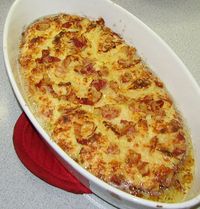Gnocchi alla Romana: Difference between revisions
imported>Hayford Peirce (let's see if we can enter a gallery of pix here, using the tagliatelle article as a template) |
imported>Hayford Peirce (added the other nine pix) |
||
| Line 6: | Line 6: | ||
<center> | <center> | ||
{{Gallery-nomix | {{Gallery-nomix | ||
|caption= A | |caption= A homemade preparation of ''gnocchi alla romana'' | ||
|width=130 | |width=130 | ||
|lines=5 | |lines=5 | ||
| | |Gnocchi 1.jpg|The cooked semolina and milk mixture, with the egg-cheese mixture ready to be added | ||
|Gnocchi 2.jpg| | |||
|Gnocchi 3.jpg| | |||
|Gnocchi 4.jpg| | |||
| | |Gnocchi 5.jpg| | ||
| | |Gnocchi 6.jpg| | ||
| | |Gnocchi 7.jpg| | ||
| | |Gnocchi 8.jpg| | ||
| | |Gnocchi 9.jpg| | ||
| | |Gnocchi 10.jpg| | ||
| | |||
| | |||
| | |||
}} | }} | ||
</center> | </center> | ||
Revision as of 16:14, 6 July 2011
Gnocchi alla Romana, or, less often, gnocchi di semolino alla romana, is a popular Italian dish that is made with semolina flour instead of the potatoes used in the more usual kind of gnocchi widely made in both Italy and France. "Gnocchi" in Italian means "lumps", as those gnocchi made from potatoes are definitely lump-like in appearance. One English translation of the Roman version is "semolina cakes baked with butter and cheese". [1] Rather than being lump-like, though, they are thinnish, relatively smooth disks that have been cut like cookies or biscuits from a sheet of cooled dough. Originally eaten primarily in Rome, where it remains a standard of family kitchens, gnocchi alla Romana has now spread throughout Italy. It is also made in France, where it is called gnocchi de semoule. Its ingredients are simple, and readily available in most homes: milk, semolina flour, eggs, Parmesan cheese, and butter, with salt, black pepper, and nutmeg as seasonings. The well-known Italian cooking instructor Marcella Hazen adds small strips of prosciutto, bacon, or boiled ham to the top of dish, but this is far from standard. [2] "Semolina," Julia Child tells us, "is farina, which in turn is the residue of middle-sized particles left over from the sifting of durum wheat, the type of wheat used for making macaroni." [3] Gnocchi alla Romana can be served as either the first or second course of a meal, or, in larger quantities, as the main course.
| A homemade preparation of gnocchi alla romana | ||||||||||||||||||||
| ||||||||||||||||||||
References
- ↑ Recipes: The Cooking of Italy, Time-Life Books, Foods of the World, New York, 1968, Library of Congress catalogue card number 68-19230, page 33
- ↑ Essentials of Classic Italian Cooking, by Marcella Hazan, Alfred A. Knopf, New York, 1992 ISBN 0-394-58404-X, page 264
- ↑ Mastering the Art of French Cooking, by Simone Beck, Louisette Bertholle, and Julia Child, Alfred E. Knopf, New York, 1961, L.C. catalog card number 61-12313










